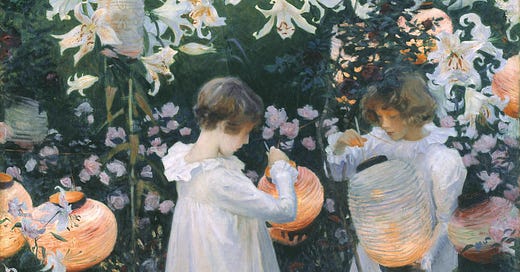suggested reading method
To best savour this artwork, please take a moment to eliminate distractions. Consider minimizing all other windows on your computer; putting other devices (phone, tv etc) aside; taking a deep breath, to the full extent of your lung capacity; and focusing solely on the “artwork” section.
Once you’ve processed that to your satisfaction, the rest of the post is optional reading, provided only to share my own impressions and reasons for choosing this piece.
artwork
Carnation, Lily, Lily, Rose by John Singer Sargent. 1887. Oil paint on canvas.
interpretation
I first encountered Carnation, Lily, Lily, Rose after my dad cited Sargent as his favourite painter. A high honour, I thought, knowing my dad has worked as a graphic designer and art director for over 30 years. I discovered more and more of Sargent’s stunning oil paintings, which show excellent command over mark-making, and reveal something of the sitter’s personality in the unique way great portraits can.
I could have chosen anything from Sargent’s oeuvre just as well, but I appreciate the considerable time that went into sharply refining the grass and flowers in this piece – bright enough to stand out, without overwhelming the figures.
What is most striking about this painting is the unusual lighting. The cool purples against the warm, orange glow of the lanterns evoke an early evening – after the “golden hour” of sunset that photographers love, but before full darkness. The various shades blended into the girls’ white dresses, especially, are masterful.
If a photograph can capture a moment, this makes me believe a painting can as well. Not simply a moment in time, either, but also a moment of flickering light; of full bloom in the garden; of these innocent, curious children’s lives.
Carnation, Lily, Lily, Rose is simultaneously drawn from a real-life scene, and lifted above reality into an ethereal realm.
context
John Singer Sargent is an American artist (1856-1925) who was born in Florence and spent much of his career in England. He specialized in portraiture, and painted hundred of oils and watercolours.
According to the Tate Modern, Sargent worked on this picture outdoors over the summers of 1885 and 1886, for a few minutes each day, in order to capture the particular light of dusk: “He would place his easel and paints beforehand, and pose his models in anticipation of the few moments when he could paint the mauvish light of dusk.”
Additionally, “The title comes from the song 'The Wreath', by the eighteenth-century composer of operas Joseph Mazzinghi, which was popular in the 1880s. Sargent and his circle frequently sang around the piano at Broadway. The refrain of the song asks the question 'Have you seen my Flora pass this way?' to which the answer is 'Carnation, Lily, Lily, Rose'.” (Unfortunately I can’t find this song online, but I enjoy the image of a casual sing-along with friends.)
Feel free to share your own thoughts in the comments!
If you enjoyed this post, please consider subscribing and telling your friends about Spirit :)





Such a charming choice of imagery! As you point out, the dusk lighting is superbly rendered- truly ethereal.
Thank you for taking me out of the tiresome quotidian crush, and for reminding me of the soulful, restorative value of a moment’s respite from the madding crowd.
Love, D